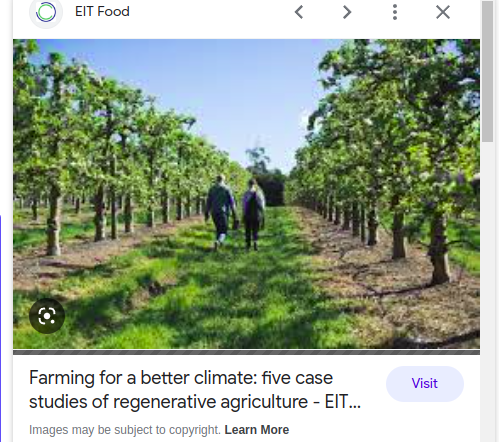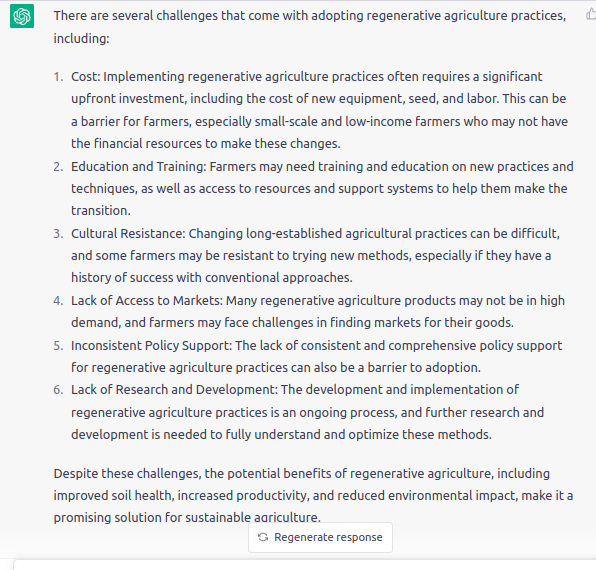I would like to propose a single, though multi-dimensional framework to structure the solution to our human relationship with the Earth. Once that is in place the problems fall into place on their own and are directly measurable as 'distance from the solution'.
The Framework under which I am going to work is called Regenerative Agriculture, which I am going to work to (re)define for purposes of the integral (global) discussion to solve our problems (by defining solutions).

Here is the cultural milieu:
Regenerative agriculture is a growing movement that aims to restore degraded lands, promote biodiversity, and enhance the health of both the soil and the people who depend on it. By utilizing practices such as cover cropping, crop rotation, and reduced tillage, regenerative agriculture can improve the resilience of agricultural systems and help to mitigate the impacts of climate change. As the world faces increasing challenges in feeding a growing population while reducing the environmental footprint of agriculture, regenerative practices offer a practical and realistic solution to the current crisis. In this article, we will explore the benefits and challenges of adopting regenerative agriculture and the impact it can have on our planet and its inhabitants.
According to ChatGPT:

There are several challenges that come with adopting regenerative agriculture practices, including:
1 - Cost:
2 - Education and Training
3 - Cultural Resistance
4 - Lack of Access to Markets
5 - Inconsistent Policy Support
6 - Lack of Research and Development
Despite these challenges, the potential benefits of regenerative agriculture, including improved soil health, increased productivity, and reduced environmental impact, make it a promising solution for sustainable agriculture.
I include here, some information from ChatGPT, as a snapshot of our current collective unconscious regarding the idea of 'Regenerative Agriculture', as well as the built-in resistance points, before I go to work. This article will define the framework, so that a future work can be dedicated to responding directly to these concerns. I include them here because everything is circular and context is king.
Connecting the dots
I want to try to connect some dots today. According to the news, Jordan Peterson has launched some sort of initiative of 'real solutions'. This is my response, and what a better time than ever to review the actual situation we are in.
This guy does it justice within a solutions based framework (video does have an ad), and includes an introduction to some of the biggest wins in recent history world-wide.
The problems of the world can basically be summed up through the concept of ecosystem degradation, under this key concepts of desertification and biodiversity-loss. The climate has almost nothing to do with it, its how resilient the ecosystems are to climate.
There is a solution for degradation, and it has been implemented on large scale before, in both India and China on a spectrum of public and private management of projects. In general, we know how to fix this:
This takes a slightly different form from country to country, but the same realizations have been coming to the fore for the last 40+ years. Australia is rich with examples:
There are areas all over the world that can benefit (become enriched) with these techniques.
Order of Operations
Step 1: 1. Turning the deserts into grasslands
The first thing to consider is the water cycle, it is primary to the carbon cycle. The first phase of restorations con be conceptualized as turning desert into grassland, which is accomplished by successful activation of the Water Cycle so the carbon cycle can begin enrichment.
Here is Southeast Arizona swale project:
More and more people are doing the berm and swale in marginal areas to great effect. This is known. Here is a project based on a 3800 foot swale in the high desert:
The risks around desertification are real. Its very likely that civilizational collapses around the world previously are because of this (see final video).
Restoring Marginal lands all around the world can vastly expand the amount of productive land participating in the carbon and the water cycles. In the US, this is mostly led by private individuals.
Consider this one man project in west texas, buying cheap desert land to dig and make a desert forest. I really liked this video because he explains really well how this works from a rain perspective.
"In an average year, I should have 800 acre-feet of water flow through this wash.
Let's go again abroad and have another look at China, from a different perspective: stopping desertification. While they suffer from some problems like a lack of diverse species being used, they have created the largest man-made forest on earth and reversed desertification in several regions.
They are missing some key concepts that we will add to the cycle, but what is working can be refined, mostly by increasing biodiversity:
What about Africa?
They are working on their 'Great Green Wall', and while it may never get finished in the sense of a Chinese Mega-project, they are reigniting nodes of land protection, where the people are remembering how to care for the land and control the carbon and water cycles.
A local regeneration method in Africa is to use pits (zai)instead of swales. These pits trap fertility and can be established in increasing numbers over time, and cared for as nodes. So it is not surprising that the 9 country project is having trouble being a unified entity. There is room for cultural variation in our framework.
Learn more about some of the African experience here:
When you think about Ethopia restoring land, think about water flow down the Nile to Egypt and recent events. Water flow, or lack thereof, has real consequences.
But on both small and large scale, understanding the water and carbon cycles yields rich and growing abundance. And the number of nodes are growing around the world. Here's one in Jordan that runs a school called 'Greening the Desert':
Step 2: Pasture Principles and the Carbon Cycle
In a sense the carbon cycle is always working, but deepening the dimensions in which it can interact seems to increase in relation to organic life and the water cycle discussed in the previous section.
A profitable way to do this has recently been popularized in the US by Joel Salatin, of Pastured Poultry Profits Fame.
You might call this the 'Regenerative Ranching' method, using cow as the primary and associating optionally chicken or turkey, sheep and/or pigs into the rotation. When done correctly it is shown to increase carbon sequestration and improve soil fertility, as well as be highly profitable in the production of nutricious food. Here is one of his disciples' very successful projects.
Pasturing builds fertility overtime.
Once an area has some grass, herbivores can start to be introduced, natural or otherwise. Sometimes you might need trees in order to get grass.
Step 3: From Pasture to Forest
This can start immediately, again depending local conditions and project or farm management.
Every land is different, based principally on how much water it gets (the primacy of water), and how long it has been regenerating or degrading. The evidence shows that any land can be regenerated, even so-called wastelands or barrens.
Natural Restoration
These steps also happen naturally, this is natural restoration or 'leave it alone' model. Its not the worst model, while its great for studying and observing the natural systems, it is slow and inefficient. Sometimes this may also be the only way due to a particularily nasty invasive species, as in the award-winning example below.
From studying these examples of natural restoration we can continue learn ways to speed up the process. Gorse is a hard problem, its a national problem in Colombia as well, and it appears one viable solution is to cycle the land back through forest and shade it out.
Consideration: The Biodiversity Component
The wonderful thing about biodiversity is that it will mostly take care of itself. We must be cautious from the Chinese lessons, and make sure to use a diverse palette of plants, especially on a national scale, but you only have to look to countless examples worldwide to see that Biodiversity is trying in every moment to help us solve this, and to help show us the way forward.
Biodiversity is an amazing resource that we still do not fully understand.
Apex Stage: Agroforestry and Silvopasture management
A million models can be made, Joel Salatin-style Pastured-Profits is just one model.
Apex level systems will be dependent primarily on water availability in the region's climate and soil and secondarily on the project (farm) managers. I include this example from Spain because he highlights how fast you can jump from dryland to forest.
He also mentions a problem in the space, jealous nomenclatures. He is describing 'SynTropic' Agriculture, which I have never heard of, but the same thing also happens with Permaculture. Suffice it to say that while looking for true solutions we are generalizing from many systems, world-wide, and from many cultures.
As for myself, and my wife, we have a project in Colombia focusing on biodiversity and wood cropping. I believe there is a solution to cheap energy here as well, this video uses history to give us a historical context into the Firewood=Freedom concept of Energy Independence.
Historically, firewood has served as energy independence, especially in times of war, when all the oil goes to the government. More efficient uses of firewood have become popular recently with rocket stoves and rocket mass heater designs finding their way onto the internet.
Is it a surprise that more efficient combustion is a flourishing technology in Montana? (Where they also bury firewood in the popular cold-land hugelkultur technique).
The 'Regenerative Agriculture Framework' is the right way. It focuses human capital on productive endeavors that also regenerate and enhance ecosystem services using an industry with great historic value, which already employs billions of people and can easily expand both in small-scale and large-scale nodes.
Many of its drawbacks are actually benefits disguised by incorrect analysis, and contain productive challenges for a new generation of individuals to innovate around world-wide, all of which I hope to break-down in a follow-on article in the near future.
We do enough of this regenerative agriculture, or we flirt with collapse. This all might explain why so many of these projects include 'off-grid' concepts in their designs. The risk is real:




